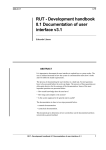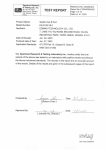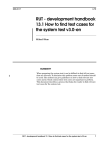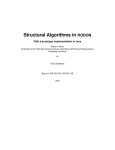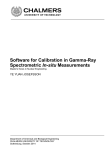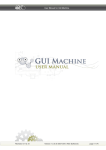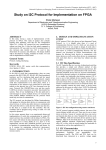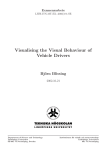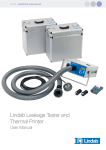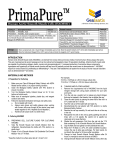Download Requirement specification
Transcript
Micro EFIS May 4, 2006 Requirement specification Mikael Lord Version 1.1 Status Examined Approved TSRT71 Automatic control project Mikael Lord c Lips Micro EFIS May 4, 2006 Project identity Spring 2006 Department of Electrical Engineering Linköping Institute of Technology Name Mikael Lord Anna Lindefelt Mikael Johansson Ville Grandin Anders Jonasson Chistian Lyzell Responsibility Documentation Test Customer Design Implementation Project leader Telephone 070 – 400 89 073 – 623 27 070 – 207 29 070 – 150 11 073 – 694 30 073 – 182 04 77 22 90 59 76 21 Email [email protected] [email protected] [email protected] [email protected] [email protected] [email protected] Homepage: http://www.cyd.liu.se/users/∼andjo752/. Customer: DST Control Customer contact: Jan-Erik Strömberg, 013–211080, [email protected] Course leader: Anders Hansson, 013–281681, [email protected] Supervisor: Jeroen Hol, 013–282803, [email protected] Tutor: Janne Harju, 013–282804, [email protected] TSRT71 Automatic control project Mikael Lord c Lips page I Micro EFIS May 4, 2006 Contents 1 Introduction 1.1 Parties . . . . . . . . . . . . 1.2 Goal . . . . . . . . . . . . . 1.3 Use . . . . . . . . . . . . . . 1.4 Background . . . . . . . . . 1.5 Notation and abbreviations . . . . . 1 1 1 2 2 2 . . . . . . . 3 3 3 3 3 3 3 4 3 OLED unit 3.1 Description . . . . . . . . . . . . . . . . . . . . . . . . . . . . 3.2 Interface . . . . . . . . . . . . . . . . . . . . . . . . . . . . . . 3.3 Requirements . . . . . . . . . . . . . . . . . . . . . . . . . . . 4 5 5 5 4 HSI 4.1 4.2 4.3 display mode Description . . . . . . . . . . . . . . . . . . . . . . . . . . . . Interface . . . . . . . . . . . . . . . . . . . . . . . . . . . . . . Requirements . . . . . . . . . . . . . . . . . . . . . . . . . . . 5 5 6 6 5 ADI display mode 5.1 Description . . . . . . . . . . . . . . . . . . . . . . . . . . . . 5.2 Interface . . . . . . . . . . . . . . . . . . . . . . . . . . . . . . 5.3 Requirements . . . . . . . . . . . . . . . . . . . . . . . . . . . 6 6 6 6 6 ESI 6.1 6.2 6.3 display mode Description . . . . . . . . . . . . . . . . . . . . . . . . . . . . Interface . . . . . . . . . . . . . . . . . . . . . . . . . . . . . . Requirements . . . . . . . . . . . . . . . . . . . . . . . . . . . 7 7 7 7 7 Setup mode 7.1 Description . . . . . . . . . . . . . . . . . . . . . . . . . . . . 7.2 Interface . . . . . . . . . . . . . . . . . . . . . . . . . . . . . . 7.3 Requirements . . . . . . . . . . . . . . . . . . . . . . . . . . . 7 7 7 7 2 System overview 2.1 Product description . 2.2 Product components 2.3 Dependences . . . . . 2.4 Subsystems . . . . . 2.5 Restrictions . . . . . 2.6 Design method . . . 2.7 General requirements . . . . . . . . . . . . . . . . . . . . . TSRT71 Automatic control project Mikael Lord . . . . . . . . . . . . . . . . . . . . . . . . . . . . . . . . . . . . . . . . . . . . . . . . . . . . . . . . . . . . . . . . . . . . . . . . . . . . . . . . . . . . . . . . . . . . . . . . . . . . . . . . . . . . . . . . . . . . . . . . . . . . . . . . . . . . . . . . . . . . . . . . . . . . . . . . . . . . . . . . . . . . . . . . . . . . . . . . . . . . . . . . . . . . . . . . . . . . . . . . . . . . . . . . . . . . . . . . . . . . . . . c Lips page II Micro EFIS May 4, 2006 8 Rotary switch unit 8.1 Description . . . . . . . . . . . . . . . . . . . . . . . . . . . . 8.2 Interface . . . . . . . . . . . . . . . . . . . . . . . . . . . . . . 8.3 Requirements . . . . . . . . . . . . . . . . . . . . . . . . . . . 8 8 8 8 9 Upgrade requirements 8 10 Reliability 9 11 Economy 9 12 Deliveries and subdeliveries 9 13 Documentation 10 14 Education 10 List of Figures 1 2 Micro EFIS box . . . . . . . . . . . . . . . . . . . . . . . . . . System hardware overview . . . . . . . . . . . . . . . . . . . . TSRT71 Automatic control project Mikael Lord 3 4 c Lips page III Micro EFIS May 4, 2006 Document history Version 0.1 0.2 0.3 0.4 0.5 Date 060203 060207 060208 060209 060216 0.6 060222 1.0 1.1 060315 060504 Changes Sign First draw CL,ML,AL Small changes and corrections CL,ML,AL Major changes and corrections ALL Some changes and corrections ML,MJ,CL 2.2 Product figure added 2.6 Hardware overview figure added 2.7 Rotary switch specified 3.3 New requirement, removal and priority change 4.3 New requirement and priority change 5.3 New requirement 6.3 Requirement extended 7.3 New requirements 8.3 New requirements and removal 9 New requirements 10 Requirement change ML,CL 2.7 Requirement 5: modularity ML,MJ,CL added Approved as version 1.0 J. Hol Requirement 8 has been added, as CL discussed with supervisor Jeroen Hol TSRT71 Automatic control project Mikael Lord Reviewed AJ ALL ALL ML,MJ,CL ML ML,MJ,CL AL c Lips page IV Micro EFIS 1 May 4, 2006 Introduction The General Aviation (GA) aircraft fleet has become very old (40+ year old aircrafts are now very common) thanks to reliable air frames and rapidly increasing prices of new light aircraft. A vast majority of these aircrafts are equipped with old-fashioned mechanical flight instruments, now reaching the end of their lifetime as the air frames become older. Instead of performing a complete upgrade of the entire instrument panel, which can result in costs often exceeding the value of the entire aircraft, one can complete the system with a much more affordable Micro EFIS. A Micro EFIS is, as the name implies, a small EFIS (Electronic Flight Information System), targeted for the GA market. It is intended as a backup system for the mechanical flight instruments. In this document the project requirements will be specified. Every requirement will be stated as: Requirement x [Py] Requirement description. The priority levels are defined as follows: P1 Highest priority. These requirements must be fulfilled before the project closure. P2 Normal. Shall normally be fulfilled, but are negotiable. P3 Lowest. These demands will be fulfilled if time allows it. 1.1 Parties Customer: Jan-Erik Strömberg, DST Control, Linköping Supervisor: Jeroen Hol, Department of Electrical Engineering, Linköping Institute of Technology Producent: A group of six students at Linköping Institute of Technology 1.2 Goal The goal of this project is to design a stripped down version of a Micro EFIS and to evaluate the implementation based on state-of-the art organic graphical display; a so called OLED display. This to ensure high endurance at extreme temperatures (down to −30◦ C). The system shall be implemented on one single FPGA to meet the need to be small in size and have a low TSRT71 Automatic control project Mikael Lord c Lips page 1 Micro EFIS May 4, 2006 cost. Since it is intented as a backup system it must have a high reliability, be independent of external systems and simple to use. To increase the ease of upgrading the system and to incrementally add functions, it shall be built in modules. 1.3 Use The system is intented as a backup for the mechanical flight instruments and the primary use is in the case of instrument failure. 1.4 Background This project is within the frame of the “Automatic Control Project Course, CDIO” at Linköping Institute of Technology. 1.5 Notation and abbreviations The following abbreviations and notations will be used: ADI Attitude and Direction Indicator A/C Aircraft DST DST Control AB: the project owner EFIS Electronic Flight Information System: a standardised terminology used for a system of sensors, computers and displays designed to present critical flight data to the pilot ESI Engine Status Indicator GA General Aviation: non-commercial air traffic (including aircraft operated by companies for internal use only) GND Ground Level GUI Graphical User Interface HSI Horizontal Situation Indicator MSL Mean Sea Level TSRT71 Automatic control project Mikael Lord c Lips page 2 Micro EFIS 2 2.1 May 4, 2006 System overview Product description The product that is going to be delivered is a Micro EFIS (Electronic Flight Information System) aimed for the GA market. It is intented to be used as a backup system for the mechanical flight instruments, in case of instrument failure. 2.2 Product components The Micro EFIS consists of an instrument casing with specific measures (60× 60 × 50 mm), with a user interface on a single monochrome display (128 × 64 pixels) and one single rotary mode selector switch. A user manual and technical documentation will be included at delivery. Figure 1: Micro EFIS box 2.3 Dependences The back panel consists of a number of multi-purpose connectors for future expansion. The six leftmost connectors are intended for connection of distributed sensor units, defined by the customer. The topmost connector on the right is used for power supply. The second connector in the right end is intended for upgrading the software of the Micro EFIS. TSRT71 Automatic control project Mikael Lord c Lips page 3 Micro EFIS 2.4 May 4, 2006 Subsystems The system will be divided into the following subsystems: OLED unit, HSI/ADI/ESI display modes, setup mode, and a rotary switch unit. 2.5 Restrictions The group does not supply any support after project closure. No garanties except fulfillment of the requirements will be given. 2.6 Design method The system shall be built in modules with well defined interfaces to enable upgrading a single subsystem independent of the others. The system shall be developed with use of VHDL, if needed a softcore will be included. One single FPGA shall be used and the use of FLASH is optional. Figure 2: System hardware overview 2.7 General requirements Requirement 1 [P1] The system shall fit in a box with dimensions 60 × 60 × 50 mm. Requirement 2 [P1] An organic LED with dimensions 128×64 pixels shall be used to display the data. TSRT71 Automatic control project Mikael Lord c Lips page 4 Micro EFIS May 4, 2006 Requirement 3 [P1] A single FPGA of type Xilink Spartan 3 model XC3S1000 shall be used for all calculations. Requirement 4 [P2] The integrated hardware/firmware development environment Protel/DXP by Altium shall be used. Requirement 5 [P1] The implementation will be modular and the code will be uniform, well structured, and commented. Requirement 6 [P1] A rotary mode selector switch of type EM11B shall be used to interact with Micro EFIS. Requirement 7 [P2] The communication between FPGA and sensors shall use RS422 protocol. Requirement 8 [P1] If the project group has not received the hardware card at the 3rd of May 2006, then all the requirements only have to be fulfilled in simulation. 3 OLED unit The OLED subsystem is consisting of the graphical display module (128 × 64 pixels) and associated hardware in the FPGA. 3.1 Description The graphical display is based on state-of-the-art organic technology; a so called OLED display. Organic materials have the benefit of operating over a wide temperature range as required by the GA market. In particular the display is guaranteed to work down to −30◦ C without any degradation in performance. Another important factor is long life expectancy since OLED displays are active emitting light by itself (as opposed to passive LCD displays requiring an external light source) it is ideal for operation in situations of total power failure. Unfortunately there are no colour OLED displays currently available on the market. Therefore the initial graphical user interface is limited to various intensities (16 levels) of the yellow light emitted by the selected display. 3.2 Interface The information given by the HSI, ADI, ESI and Setup mode shall be displayed on the OLED. TSRT71 Automatic control project Mikael Lord c Lips page 5 Micro EFIS 3.3 May 4, 2006 Requirements As the graphical display has no character generating hardware, all such functions will be implemented in the FPGA. Requirement 9 [P1] The typefaces that will be created shall be DST based and approved by Liana Pop. Requirement 10 [P2] The display shall be able to output the characters needed by the HSI, ADI, ESI, and setup mode. Requirement 11 [P3] Graphical objects such as circles, dynamic lines, and similar will be used to present data. 4 4.1 HSI display mode Description The Horizontal Situation Indicatior, HSI, provides the basic horizontal view of the A/C heading and navigation. The system usually displays data such as: roll angle, pitch angle, slip (lateral g force), air speed, pressure altitude, true elevation, vertical speed, and outside air temperature. If the A/C is equipped with a GPS system, then ground speed and true altitude also can be given. This project aims to produce a stripped downed version of an EFIS, and will only implement the most significant parts. 4.2 Interface The HSI communicates with the rotary switch, OLED unit, and sensors. 4.3 Requirements Requirement 12 [P2] The following data shall be presented in HSI mode: roll angle, pitch angle, slip (lateral g force), outside air temperature (OAT), and vertical speed (VS). Requirement 13 [P3] The following data shall be presented in HSI mode: air speed (AS), pressure altitude (PA). TSRT71 Automatic control project Mikael Lord c Lips page 6 Micro EFIS 5 5.1 May 4, 2006 ADI display mode Description ADI is an abrivation for Attitude and Direction Indicator, which is a system to present common data such as: magnetic heading, direction/track to radio beacon (if ADF or VOR receiver is provided), and outside air temperatur. If the A/C is equipped with a GPS system, then true heading and true track also can be given. This project aims to produce a stripped downed version of an EFIS, and will only implement the most significant parts. 5.2 Interface The ADI communicates with the rotary switch, OLED, and sensors. 5.3 Requirements Requirement 14 [P2] The following data shall be presented in ADI mode: magnetic heading (MH) and outside air temperature (OAT). Requirement 15 [P3] The following data shall be presented in ADI mode when GPS is provided: true heading (TH) and true course (TC). 6 6.1 ESI display mode Description The Engine Status Indicator, ESI, provides the basic information about the A/C condition such as: battery voltage, alternator current, load current, engine RPM, engine manifold pressure, engine fuel flow, engine fuel pressure, engine oil pressure, engine oil temperature, engine cylinder head temperature, and engine exhaust gas temperatur. This project aims to produce a stripped downed version of an EFIS, and will only implement the most significant parts. 6.2 Interface The ESI communicates with the rotary switch, OLED, and sensors. TSRT71 Automatic control project Mikael Lord c Lips page 7 Micro EFIS 6.3 May 4, 2006 Requirements Requirement 16 [P2] The following data shall be presented in ESI mode: date and time. Requirement 17 [P3] The following data shall be presented in ESI mode: battery voltage, alternator current, load current, engine oil pressure, and engine oil temperature. 7 7.1 Setup mode Description The purpose of the setup mode is that the user can set parameters, as seen in the requirements below. 7.2 Interface The manual setup is done by using the rotary switch and a GUI on the OLED. 7.3 Requirements Requirement 18 [P2] The real-time clock shall be programmable in setup mode. Requirement 19 [P3] The static pressure, given by air traffic control, shall be programmable in setup mode. Requirement 20 [P3] Some information displayed in the main modes (HSI, ADI) can be turned off. Requirement 21 [P3] The light intensity of the OLED shall be changeable by an external digital input. Requirement 22 [P3] There shall be two light intensity modes: normal and dimmed. The intensity levels in each mode will be adjustable. TSRT71 Automatic control project Mikael Lord c Lips page 8 Micro EFIS 8 8.1 May 4, 2006 Rotary switch unit Description The rotary mode switch has the function of switching between the different graphical modes as described above. It utilizes a button integrated with a rotary switch. 8.2 Interface The rotary switch sends its signals to the FPGA. 8.3 Requirements Requirement 23 [P1] The rotary switch shall be robust and “bounce free”. Requirement 24 [P2] The rotary switch shall handle turns and single tap. Requirement 25 [P3] The rotary switch shall handle long and double taps 9 Upgrade requirements There shall be a way to upgrade the Micro EFIS with new future functions. Requirement 26 [P1] Software upgrades will be downloaded via serial protocol RS232. Requirement 27 [P3] A version number system will be developed to ease version control at upgrades. Requirement 28 [P3] An upgrading software for Windows will be developed. 10 Reliability The most important property of the system is not that it is fast and effective but that it works every time. I.e. it is more important that the system is robust than it having high performance, although high performance is desired. Requirement 29 [P2] The system shall be able to run for several hours without failure. TSRT71 Automatic control project Mikael Lord c Lips page 9 Micro EFIS 11 May 4, 2006 Economy The total number of working hours should be about 1200. Requirement 30 [P1] The number of tutor hours available is 40. 12 Deliveries and subdeliveries The list below specifies the decision points (DP) at which the deliveries shall be made. The date for the DP1 is set to 2006-02-16 and DP2 2006-03-01. The final decision point DP6 is set to 2006-05-19. For remaining DP, see the project plan. Requirement 31 [P1] The requirement specification shall be delivered at DP1. Requirement 32 [P1] The system outline shall be delivered at DP2. Requirement 33 [P1] The project plan shall be delivered at DP2. Requirement 34 [P1] The time plan shall be delivered at DP2. Requirement 35 [P1] The design specification shall be delivered at DP3. Requirement 36 [P1] The test plan shall be delivered at DP3. Requirement 37 [P1] The test results shall be delivered at DP5 Requirement 38 [P1] The user manual shall be delivered at DP5 Requirement 39 [P1] The final product shall be delivered att DP5 and be presented to show that the requirement specification is fulfilled Requirement 40 [P1] Technical documentation shall be delivered at DP6 Requirement 41 [P1] The project homepage shall be delivered at DP6 TSRT71 Automatic control project Mikael Lord c Lips page 10 Micro EFIS 13 May 4, 2006 Documentation The purpose of the documentation is to inform the customer about the product, to be a tool to structurize the project, make it efficient/effective and to capture the experience for future work. Requirement 42 [P1] The documents of the project will be written in LATEX c and use the Lips document structure. c The following documents shall be produced according to Lips: • Requirement specification • System outline • Project plan including list of activities • Time plan • Design plan • Test plan • Test results • Time report including status report • Technical documentation • Reflection • User manual 14 Education Education in fields such as LIPS-model, OLED and FPGA will be given if needed by ISY and DST Control. References [1] Tomas Svensson & Christian Krysander, Projektmodellen Lips, kompendium, Linköpings Tekniska Högskola, Version 1.2. [2] George Grätzer, Math into LATEX, Birkhäuser, 1996. [3] Jan-Erik Strömberg, Requirement specification – Micro EFIS, DST Control, MEFIS/Doc/Spec/R0543S01.fm, version 1.0.0. TSRT71 Automatic control project Mikael Lord c Lips page 11
















